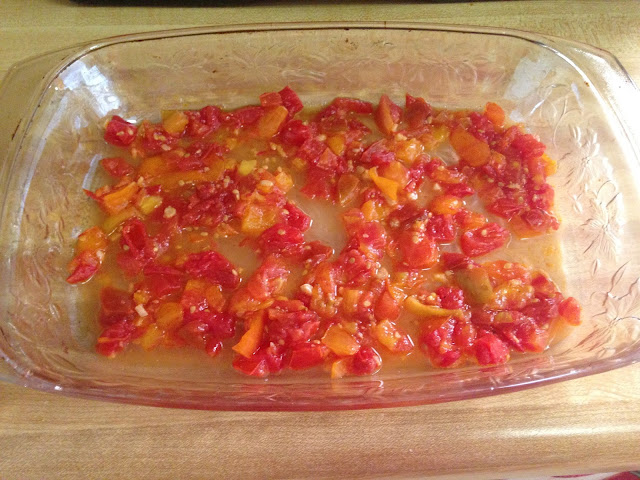Caponata is a southern Italian eggplant relish/side dish. The base typically includes eggplant, celery, onion, olives, tomatoes, olive oil, of course, and red wine vinegar and sugar which gives it its signature agrodolce (sweet and sour) flavor. Other ingredients can include pine nuts, sweet peppers and raisins. The Sicilians sometimes throw in tuna. It is always served at room temperature.
It is perfect as part of an antipasti plate or side dish along side chicken or fish or on grilled country bread as bruschetta or on polenta or with pasta. Nice stuff! I think you will like it. The amounts in the recipe below are approximations. You might need to make it a few times to get the amount of ingredients and the timing right to suite your own taste. Like a lot of Italian food, this gets better over the next few days, so you can make it ahead of time and keep it in the refrigerator. Don’t re-heat it though, just let it come to room temperature by itself.
Caponata alla Fuscà
2 large or 3 medium size eggplants
1/2 - 3/4 cup of olive oil
2 cups of celery, sliced thin on a bias
3/4 cup of onions, chopped
2 cups of drained canned Italian plum or chopped fresh tomatoes
2 tablespoons of tomato paste
9 - 11 large green olives, pitted and cut in half - use the good ones: Cerignola or Castelvetrano. In a pinch Kalamata olive will be OK but NOT grocery store green olives stuffed with a pimento.
2 tablespoons of capers –
rinsed
1/2 cup of red wine vinegar, mixed with 2 tablespoons of sugar
Handful of golden raisins
2 tablespoons of pine nuts – toasted
PInch + Hot red pepper flakes (optional)
Basil – nice handful torn into pieces
salt and ground pepper to
taste
Cut eggplant into 1 inch cubes. Sprinkle cubes of eggplant with salt and set them
in a colander in the sink to drain. After 30 minutes, rinse them and pat dry
with paper towels and set them aside.
Heat 1/4 cup olive oil in heavy non-stick skillet, saute the eggplant in it, stirring and turning for about 8-10 minutes until they are lightly browned but not mushy. You might have to add more olive oil. With a slotted spoon transfer the eggplant to a bowl.
Using the same skillet, add about 1/4 cup oil to the oil that’s left in the skillet and add the celery and onions. Cook over moderate heat, stirring frequently for about 10 minutes until celery and onions are soft and lightly colored.
Add tomato paste and cook, stirring, until caramelized and almost evaporated, 1–2 minutes. Add crushed tomatoes or chopped fresh tomatoes and continue cooking for 10 minutes.
Stir in the olives, vinegar & sugar, raisins, capers and cook, stirring occasionally, about 10 minutes.
Take off heat and add back the eggplant, add the pine nuts and basil.
Stir it all together. Serve at room temperature.






































